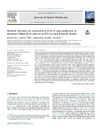Identificador persistente para citar o vincular este elemento:
https://accedacris.ulpgc.es/jspui/handle/10553/73571
| Título: | Nutrient footprint and ecosystem services of carp production in European fishponds in contrast to EU crop and livestock sectors: European carp production and environment | Autores/as: | Roy, Koushik Vrba, Jaroslav Kaushik, Sadasivam J. Mraz, Jan |
Clasificación UNESCO: | 310502 Piscicultura | Palabras clave: | Cleaner Production Environmental Burden And Ecosystem Services Eu Agriculture And Livestock Sectors Eutrophication Nitrogen And Phosphorus, et al. |
Fecha de publicación: | 2020 | Publicación seriada: | Journal of Cleaner Production | Resumen: | There have been some arguments concerning supplementary feed (cereals) based common carp production in fishponds and water pollution, mostly in Central Europe. Using Czech Republic (top producer in EU) as a benchmark and combining data on nutrient digestibility of feedstuffs used combined with analyses of literature data, we have assessed – nutrient footprint (∼9.4–10.8 kg N ha−1, ∼2.7–3.2 kg P ha−1; 1.5–4 × < EU crop-livestock sectors); nutrient utilization efficiencies (NUEN ∼36%, NUEP ∼50%; 1.5–1.7 × > EU livestock average); autochthonous nutrient removal (∼8–9.2 kg N ha−1, 1.4–1.6 kg P ha−1); eco-cost burden (13–29 × ≪ positive services); eco-services (∼74.5–100.6 million € country−1; ∼2375 € ha−1) of carp production in Central Eastern European Region (CEER). Digestible nutrients offered by natural prey (7.9% N, 1% P on dry matter basis) to carp are ∼5–8 times higher than those provided by cereals and remains the key determinant for production. Despite this, 70–90% of nutrient footprint from feeding is contributed by cereals. Neutral footprint (∼374 kg ha−1) and exclusively natural (up to 300 kg ha−1) carp production intensities were identified, following which, commercial interest of carp farming may falter (costing intangible losses >56.5 million € in CEER), despite achieving ‘greener-goals’. Per production cycle, carp aquaculture in CEER fishponds offer at least 579 million € worth of services. Our results show that carp production in ponds have lesser nutrient burden than crop and livestock productions in EU. Existing management of fishponds ‘barely meet’ optimum P requirements of common carp and present production intensity should not be vilified as a pollution causing activity. Risks and solutions for achieving both environmental (minimized footprint) and aquaculture goals (uncompromised production) are discussed. | URI: | https://accedacris.ulpgc.es/handle/10553/73571 | ISSN: | 0959-6526 | DOI: | 10.1016/j.jclepro.2020.122268 | Fuente: | Journal of Cleaner Production [ISSN 0959-6526], v. 270, 122268, (Octubre 2020). |
| Colección: | Artículos |
Citas SCOPUSTM
41
actualizado el 08-jun-2025
Citas de WEB OF SCIENCETM
Citations
42
actualizado el 12-ene-2026
Visitas
55
actualizado el 10-ene-2026
Descargas
180
actualizado el 10-ene-2026
Google ScholarTM
Verifica
Altmetric
Comparte
Exporta metadatos
Los elementos en ULPGC accedaCRIS están protegidos por derechos de autor con todos los derechos reservados, a menos que se indique lo contrario.
